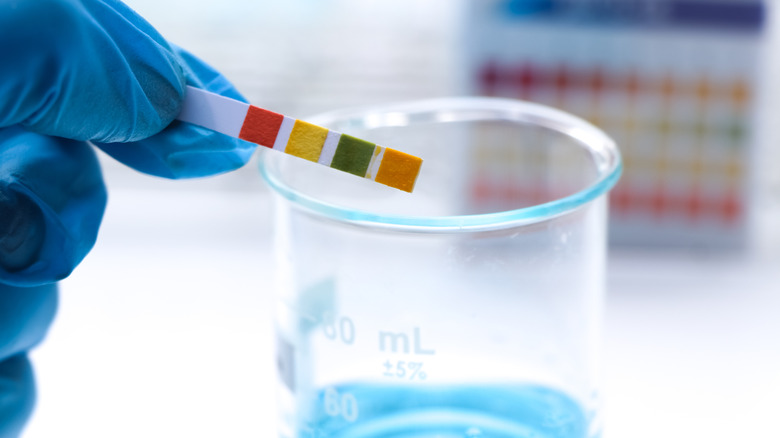How To Calculate The PH Of NaOH
The pH scale, which ranges from 0 to 14, tells you how acidic or alkaline a solution is. A pH lower than 7 is acidic, while a pH higher than 7 is alkaline. In mathematical terms, pH is the negative logarithm of the molar concentration of hydrogen ions in the solution. A pH testing strip will tell you that NaOH (sodium hydroxide) is a strong alkaline, but to calculate its exact pH, you have to work out its molarity first.
Calculating molarity
Molarity (M) is the concentration of a solution expressed as the number of moles of solute per liter of solution, using the formula M = moles solute ÷ liters solution. The first step is calculating the number of moles of solute present. If you have dissolved 1 gram of NaOH in enough water to make a total of 250 milliliters of solution, calculate the number of moles of solute present by diving the mass of NaOH by the molecular mass of the compound. The molecular mass of NaOH is 40, so work out 1 ÷ 40 = 0.025.
Next, calculate the number of liters of solution present. In this example, you have 250 milliliters of solution. Convert to liters by dividing by 1000, because there are 1000 milliliters in 1 liter. Work out 250 ÷ 1000 = 0.25.
Next, divide the number of moles of solute by the number of liters of solution. Work out 0.025 ÷ 0.25 = 0.1. The molarity of the NaOH solution is 0.1 M.
Ionization of NaOH
Ionization is the addition or removal of an electron to create an ion. Losing an electron creates a positive ion, and gaining an electron creates a negative ion. An aqueous solution of NaOH (NaOH + H2O) results in Na+ and OH- ions. Because NaOH is a strong base, it ionizes completely in water. This means 0.1 mol of it will dissociate into 0.1 mol of Na+ and OH-.
Calculating pH
To calculate pH, apply the formula pOH = -log[OH-]. Work out -log[0.1] = 1. Next, apply the formula pH + pOH = 14. To isolate the pH, work out 14 – 1 = 13. The pH of your NaOH solution is 13.
